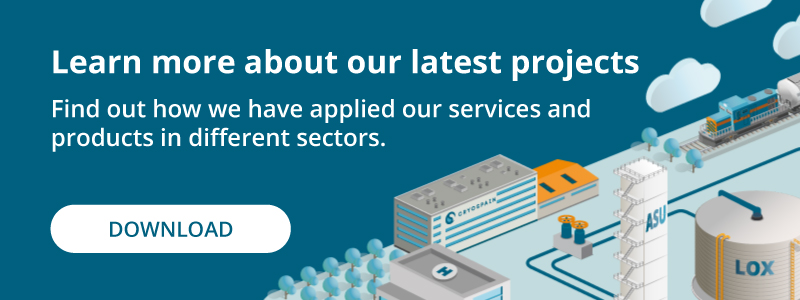In short, cryogenic food processing is a technique that involves the use of low temperatures to preserve food. However, this brief definition hardly explains the incredible value of this tool for the contemporary food industry.
In recent years, consumer expectations regarding food have been transformed: on the one hand, the demand for meals that are quickly prepared is rising; on the other hand, high quality is sought.
In this sense, the cryopreservation of food allows these expectations to be met, preserving all the taste and nutritional qualities of food, even in food products that are more fragile or are classified as “processed”.
But the importance of cryogenic food processing goes beyond this: the World Economic Forum estimates that food production will have to increase by 60% by 2050 to meet global demand. Thus, it is expected that advanced techniques that enable cryogenically frozen food will open the door to extending the availability of food and reducing waste.
Keep reading: Cryogenic Industrial Solutions that every cryogenic company should offer
The use of food gasses is directly at the center of these advances, with applications that go beyond food cryogenics, including packaging with innovative techniques.
In this context and building from our experience in cryogenic engineering, at Cryospain we analyze what exactly is cryogenic food processing, its advantages and how we can help you apply it.
Cryogenic food processing: what is it?
Cryogenic food processing is a food preservation technique that involves the application of extremely low temperatures (below -150°C) to maintain the freshness and quality of food products.
In order to do this, liquid nitrogen or liquid CO2 are mainly used, so as to reduce product temperature and, therefore, slow down or completely stop deterioration processes and enable the cryopreservation of food.
Thus, the use of specialized equipment and processes based on reaching cryogenic temperature moves away from conventional refrigeration and freezing processes, as it allows for very quick and homogeneous freezing.
This, in turn, translates into preserving the sensory and nutritional characteristics of foods effectively, as we explain further down in this article.

Cryogenic food processing is a particularly versatile technique, and can be applied to products including meat, fish, fruits and vegetables, as well as raw and processed foods.
At the same time, there are various techniques for enabling the transfer of refrigeration energy and, therefore, enabling refrigeration and freezing, including:
- The use of liquid nitrogen in liquid-solid contact techniques but also by spraying, by immersion or by convection (the latter involving the use of fans).
- Employing liquid CO2 requires solid-solid contact, transforming the element into carbonated snow using specialized equipment.
Benefits of cryogenic food processing
Conservation and food safety
Cryogenic food processing allows the freshness and quality of food to be preserved in a highly effective way, as it creates a hostile environment for the proliferation of microorganisms, extending the shelf life of foods for long periods. In fact, 1 kilogram of CO2 or 1 kilogram of nitrogen releases 80 calories of cold, on average.
Quality
One of the main advantages of cryogenic food processing is its high freezing speed, which translates into decisively preserving the quality of the food.
Conventional (slower) refrigeration leads to the formation of ice crystals in extracellular spaces and cellular dehydration. These two events can affect the texture, flavor and quality of food products after being defrosted.
On the contrary, cryopreservation of food, which is faster, does not allow the formation of large ice crystals and preserves cellular integrity, therefore preserving the qualities of the food in terms of texture and flavor.
Keep reading: Cryogenic equipment: examples, uses and how to choose the right supplier
Avoid water losses
Conventional freezing processes cause water losses, as water evaporates. This is particularly harmful for hot or prepared foods. In the case of cryogenic food processing, water losses are minimized, which in turn translates into enhanced quality.
More distribution options
Cryogenic food processing opens the door to long-distance distribution of food, enabling its global availability.
Main applications of cryogenic food processing
Cryogenic freezing
As we have just seen, the freezing of food through cryogenic processes guarantees the product quality.
The use of liquid nitrogen or another refrigerant allows food to be frozen in a matter of seconds or minutes, preventing the formation of large ice crystals and reducing cellular damage.
In addition to prepared products, cryogenic freezing is also particularly useful for preserving fragile food products or products that tend to stick together.
Surface freezing
In this case, cryogenic food processing seeks to harden food surfaces, while the interior remains partially thawed. This prevents deformation and is useful in various processes, including ice cream production, as well as cutting or transport operations.

Cooling
In this case, food is kept at low temperatures, but not frozen. This technique is useful during the storage or transportation of fresh products (fruits, vegetables, meats, dairy products…) that could be damaged by freezing, while limiting the development of microorganisms.
Temperature control
Liquid nitrogen or other cryogenic refrigerants can be used to preserve product quality at different stages of processing and storage.
Cryospain: experts in cryogenic tailor-made equipment for preserving food gasses
At Cryospain, we offer our experience and knowledge in cryogenic engineering for the development of cryogenic food processing solutions.
As such, we offer personalized end-to-end storage solutions: from design to installation and maintenance. At the same time, we provide our clients with technical and specialized consulting services to guarantee the design and implementation of the most appropriate gas storage and distribution systems.
Want to learn more? Discover our tailor-made equipment and get in touch with our team to find out how we can help you implement cryogenic food processing successfully.










 Contacte-nos
Contacte-nos